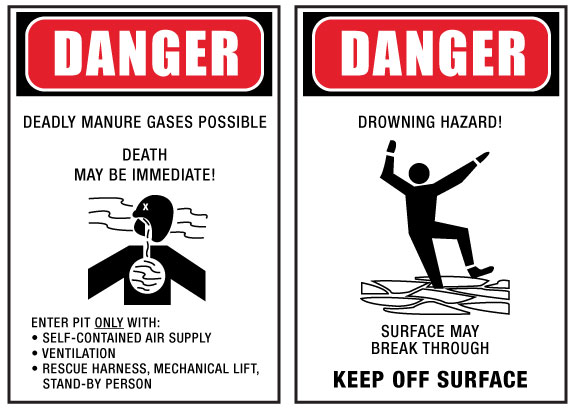An article published in the Journal of Agromedicine provides a summary of the frequency and characteristics of deaths related to on-farm manure storage and handling facilities for the period 1975 – 2004. Sources included published government reports, national and local media, online searches, published farm fatality reports and prior litigation.

The data included 77 fatalities and 21 severe injuries in the United States and 14 fatality cases from outside the U.S. The largest percentage of deaths (34 percent) occurred to persons conducting repair or maintenance activities on manure-handling equipment, while the second-largest group (22 percent) was attempting to perform a rescue of another person.
Here are some of the highlights of that research, which was conducted by Dr. William Field of the Department of Agricultural and Biological Engineering at Purdue University and Randy Beaver, MS, loss control representative for Nationwide Agribusiness in West Lafayette, Indiana.
Manure storage systems
There are three types of manure storage systems in which injuries or deaths could potentially occur:
- Manure storage tanks located directly underneath a livestock housing area
- Manure storages located away from the livestock housing areas (e.g. open lagoon or pond)
- Above-ground, silo-type manure storage structures
According to the authors, the most hazardous and common types of manure storage rescues involved below-ground manure storage pits, usually under hog or dairy confinement buildings. These events become more tragic when others attempt to carry out rescues without appropriate precautions – and thus become secondary victims.
Back in 1993, the National Institute for Occupational Safety and Health (NIOSH) issued a warning that emphasized the severity of the hazards associated with manure storage and handling facilities. This notice indicated that the number of fatalities was likely underreported, due to imprecise or insufficient farm fatality surveillance mechanisms.
Reporting problems contributed to the confusion. For example, the terms “suffocation” and “asphyxiation” were used interchangeably by medical examiners and coroners to categorize deaths in both grain storage structures and manure storage facilities.
Warm weather equals more fatalities
Research suggests that conditions at manure handling and storage facilities become worse in the presence of heat and humidity. NIOSH has warned that warmer or more humid weather and increasing barometric pressure can accelerate the production and accumulation of hazardous gases.
Sixty percent of the cases identified in this research occurred in the months of May through August. And 20 of the documented deaths (26 percent of all cases) occurred in August, typically the hottest and most humid month of the year.
Types of livestock operation and facilities
Of the 77 U.S. fatality cases, 42 (or 54.5 percent) were associated with dairy operations, 34 (44 percent) with swine operations, and one (1.5 percent) was unknown. This is interesting to note, since more attention is given to this topic in swine-focused periodicals and journals than those in dairy-related ones.
Below-ground, enclosed manure storage structures and sump pits accounted for 65 (84 percent) of the 77 fatal cases, while open lagoons only accounted for eight of the documented cases. The potential for a highly toxic environment within these enclosed spaces, and difficulty of rescue, would contribute to this high percentage of fatal cases.
What was the victim doing?
In terms of what the worker was doing at the time of death, there were seven general categories, including an unknown category. The largest category was “repair,” and this included clearing, cleaning, repairing, moving, retrieving, fixing and checking the equipment and facility components.
The “rescue” classification identified those activities undertaken by other victims who were attempting to rescue a relative, employee or other person.
There were 13 cases in which witnesses stated that prior to the time of the incident, the victim was “playing” and was discovered missing. In all of these cases, the victims were children. PD
—Excerpts from Penn State Cooperative Extension Agricultural Safety and Health News, Vol. 21, No. 5, September/October 2010
Recommended safety practices
Here are some prevention strategies to keep in mind.
- Identify manure and waste pits as confined spaces.
- Construct manure storages to allow someone to service all components from outside the pits.
- Equip manure storage systems with a powered ventilation system. A new consensus standard will soon be available to help with this.
- Never enter manure storages or pits without a self-contained breathing apparatus, a safety harness attached to a tripod lifting device and a helper standing by.
- Cover entrances to waste pits with a grate-like cover.
- Instruct workers to never enter a manure pit or any other confined space to attempt a rescue without appropriate safety equipment.
- Be sure manufacturers of manure waste pit systems include hazard warnings.
- Limit or restrict access to lagoons and other outside pumping or treatment facilities.
- Place sufficient “DANGER” and “WARNING” signs to notify a potential rescuer.
- Use air-monitoring equipment to identify a potentially hazardous atmosphere.

-
Dennis Murphy, Ph.D.
- Extension Safety Specialist
- Penn State University
- Email Dennis Murphy, Ph.D.





